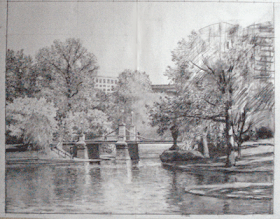
Above you see a sphere showing the PARTS OF THE LIGHT. They are;
1) The half tone, that's the value (degree of light to dark) of the object as it appears in the light.
2) The point on the sphere that faces most towards the light source and reflects that light to us is the highlight.
3) The shadow edge, which is where the light no longer hits the surface of the object, this is the bedbug line, I will explain that in a moment.
4) The shadow has a minor, lighter area within it called the reflected light.
5) The sphere throws a shadow onto the surface behind it called the cast shadow.
It is through this organized presentation of the light hitting an object, that the form of that object is represented. We have no other way of representing an object other than by a description of the light hitting it. Most of drawing is either measuring the proportions of one part of an object as related to another, or presenting the form through a representation of its values.
I intend to spend some time describing the different parts of the light I have labeled above. Today I shall deal with the most important. That is the BED BUG LINE. Your drawing book doesn't call it that, usually it is referred to as the shadow edge. My teacher R.H.Ives Gammell (more about him later) used that whimsical title to teach me a valuable lesson that I have never forgotten. Here it is:
A bed bug walking across the surface of the sphere steps boldly from the light into the shadow. That's it!
That means our tiny bug is EITHER IN THE LIGHT, OR HE IS IN THE SHADOW. Why that is very important is because it means that the two worlds are totally separate . No value occurs in both. My entry of Saturday January 31st shows a value scale and you might want to take a look at that. The instant you take a note from the light part of the sphere and introduce it into the shadow side of the sphere the illusion of form vanishes. This is the most important thing you can know about representing light. It sounds obvious and easy, however in practice it is one of the places where most students run into problems with their drawing. I will join them at their easel and touch the heel of a brush to some random point on their drawing and ask them, is this in the light or is this in the shadow? They often don't know and they try to explain how it's dark but it's in the light or it's somehow not in either. Every time your brush (or pencil , charcoal , whatever) hits the canvas you MUST know whether it is in the light or the shadow. Its one or the other every time.
Here's another photo of the Boston Public garden drawing progressing. I am pretty much working from left to right on it. Tell you why tomorrow, along with more on the parts of the light.

STAP,
ReplyDeleteStudying the bed bug line with a painting of a apple I did, I noticed that there is a range of value between the light side and dark side of the apple. It looks as if this value could belong to both,(darkest light or lighest dark)? also my reflective light looks like my darkest lights. Will the type of surface determine how much reflective light there will be. This was a good lesson learned
James, Don't eat that apple!
ReplyDeleteThanx for the question,
I will address this in an entire post. The answer is longer than a reply to a comment should be, and I think people often don't read the comments. I would like to get this answer up on the frothing surface of my blog. Today's post was written last night,after the light failed, as is my practice, so I will incorporate the response to your fine question in tomorrows post. Lay down on your studio floor with your arms at your sides and wait quietly until it appears.............Stape.
Hi Stape,
ReplyDeleteI discovered your blog just a week or two ago and have been enjoying it immensely. I followed a link from another site to your brilliant section on edges. Now I’m going through all of your older posts. It's always a thrill to discover a blog where I truly learn new things! :)
I do have to disagree with your definition of highlights. Contrary to popular opinion and the explanations found in many art instruction books, the location of the bright highlight (“specular” highlight) on an object is NOT on “the side that faces most toward the light source”, but rather depends on the position of the viewer, and moves when the viewer moves. This is easily tested and observed. It is found between the light source and the viewer, where “the angle of incidence equals the angle of reflection.” See David Briggs’s very helpful explanation and diagram: http://www.huevaluechroma.com/021.php